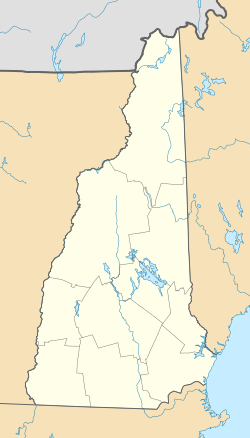Colburn Park Historic District facts for kids
Quick facts for kids |
|
|
Colburn Park Historic District
|
|

Colburn Park
|
|
| Location | N., S., E., and W. Park Sts., 3 Campbell St., 1 School St., 1 Bank St., and 9-10 Lebanon Mall, Lebanon, New Hampshire |
|---|---|
| Area | 12 acres (4.9 ha) |
| Built | 1792 |
| Architectural style | Chicago, Colonial Revival, Queen Anne |
| NRHP reference No. | 86000782 |
| Added to NRHP | January 10, 1986 |
The Colburn Park Historic District is a special area in the heart of Lebanon, New Hampshire. It includes Colburn Park, a large rectangular park, and the historic buildings around it. This district also has some older buildings from the 1800s nearby. It covers about 12 acres (that's like 9 football fields!) and was added to the National Register of Historic Places in 1986. This means it's recognized as an important historical place in the United States.
Contents
Discovering Colburn Park's History
Colburn Park is located a short distance from the Mascoma River. The river makes a big curve to the north, and right inside that curve is the center of Lebanon.
How the Park Began
The story of Colburn Park started in 1792. A man named Robert Colburn generously donated the land. His idea was for it to be the spot for the community's meeting house. A meeting house was a very important building back then. It served as both a church and a place for town meetings.
Soon after, important roads were built leading to this area. This helped the park area grow into a busy center for businesses and town activities in the early 1800s.
Important Buildings and Changes
In 1828, the Greek Revival First Congregational Church was built. It was designed by a famous architect named Ammi Burnham Young. You can still see some of the very first houses from that time around the park.
Later, in 1849, the original meeting house was moved. It was placed where the City Hall stands today.
A Town Rebuilds and Grows
In 1887, a huge fire swept through Lebanon's main business area. Over 80 buildings were destroyed! Luckily, the area right around Colburn Park was not directly hit.
However, Lebanon continued to grow, and its business district expanded. This led to some houses around the park being moved. Many new Victorian-style buildings were built around the park's edges.
After another fire in 1923 destroyed the town hall, the area around Colburn Park changed again. Many of the buildings you see today were built in the late 1800s or early 1900s. They give the park a special look, showing how the town grew and rebuilt over time.



